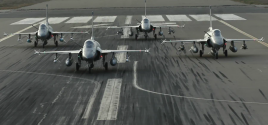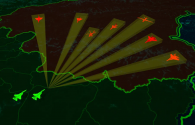Apologies if it comes too close to OT but this comment sparked my interest in the potential market for JF-17. I never thought about this so I gave it a shot and here's what came out:
I think what distorts the picture is the fact that we don't think how platform influences upgradeability and how marketing and PR influence perception.
We also focus too much on JF-17 as air-to-air when it can serve as a strike aircraft with air-to-air capabilities. Air power is primarily for striking ground targets, air-to-air is for enabling it. That may be the potential for JF-17 in the future - a better Su-25 rather than a better J-7.
- J-7 can't fit better sensors because of its size but if it did we would see it in action more often and instead we only see upgradeable platforms
- A-37 is used regularly throughout South America but we don't see it because they are not part of PR intended for current products
The aerospace industry is in a peculiar place right now as there are no cheap "proper multirole" aircraft already in production or entering production apart from:
Tejas and FA50 use G404 which grounds the plane in case of shortage or embargo while JF-17C has potentially two engines: RD-93 and WS-13.
- CAC/PAC JF-17C Block III
- HAL Tejas Mk1A
- KAI FA50 Block2/PL
Western aircraft are too expensive. T-7 won't make it to the market. Turkey plans to replace F-16s with 5gen. Lack of outsourced F-16 production will maintain cost barrier. MiG-35 is not cheap enough. Russia faces: sanctions, shortage of funds, industry busy with war, loss of status affecting preference abroad. This opens up the market that would be problematic otherwise.
From IISS The Military Balance: nominally active (additional stored)
country Su-30 Su-27 MiG-29 MiG-23 MiG-21 MiG-23BN Su-22 Su-25 F-16 F-5 Mirage A-37 J-7/F-7 JF-17 Angola 12 6 18 20 8 13 8 Ethiopia 11 8 3 Sudan 22 14 Kenya 21 Uganda 6 Tanzania 11 Mozambique 8 Namibia 6 Zambia 11 DR Congo 4 Nigeria 12 3 Tunisia 11 Syria 30 25 50 20 20 Venezuela 20 19 Cuba 5 16 Peru 19 4 (14) 12 15 Honduras 11 6 Salvador 14 Uruguay 12 Sri Lanka 5 Myanmar 32 21 16 Bangladesh 8 47 Turkmenistan 24 31 Uzbekistan 13 (11) 12 (18) 26 12 Mongolia 2 TOTAL = 764 38 30 154 67 78 28 59 76 19 43 12 47 113
If reductions due to technology occur then half of it is 388 aircraft and third is 258 aircraft. Only some of it can be replaced by J-10C or better for economic reasons.
Prospects:
Politics will be the deciding factor just like in cold war which is why my list is selective.
- Most F-7 were delivered ~10 years ago at the latest which at 20-25 nominal years of service means replacement due around 2030-35 with JF-17 being natural
- MiG-29 are nearing their life, too late for MLU and Russia doesn't have good replacement. JF-17 is also natural plus RD-33 benefits Klimov
- MiG-23 and Su-22 will not be replaced by anything more expensive - JF-17 or nothing.
- F-5s and F-16A and Cheetah/Mirage are western equivalent of JF-17
The market is there, but customer is not ready to order yet. Having used planes to facilitate faster transition is also good but PAF is not there yet.
An excellent piece.... well written article.
Political and economic influences are crucial to JF 17's success. Due to these factors JF17 has already been lost in Argentina, Malaysia, and Iraq, and more could happen soon.
Last edited:



